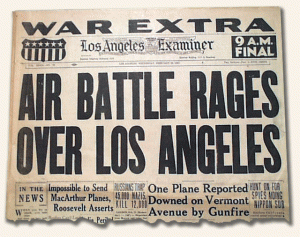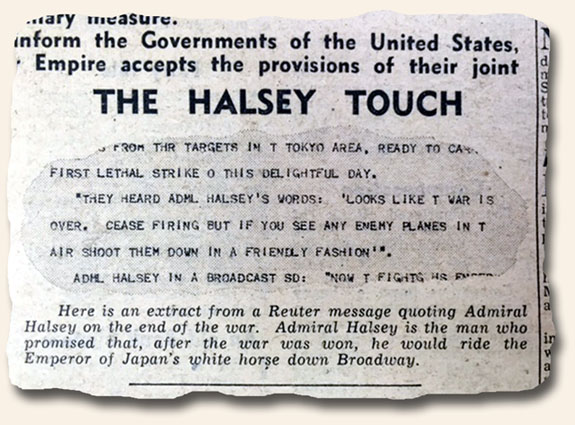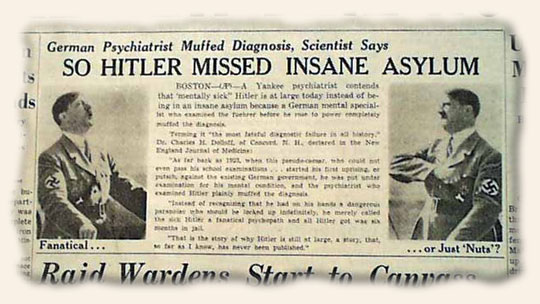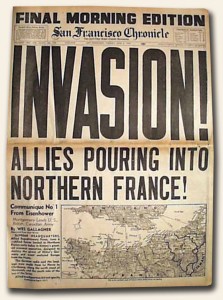The End of Something Bad… The Kickoff to Something Good…
March 24, 2022 by LauraH · Leave a Comment
 In the moment, we are often oblivious to the long-term impact significant newsworthy announcements will have as time goes on. “Henry Ford has made a car nearly anyone can afford” – eventually smog make city -living unbearable and the ozone takes a beating. “Computers can be made both inexpensively and small enough for daily use at home” – pornography spreads like wildfire. “A new substance called ‘plastic’ will revolutionize our lives” – our landfills overflow and our oceans are overcome with garbage which will take many lifetimes to decompose (if ever). However, not all unexpected “consequences” are bad.
In the moment, we are often oblivious to the long-term impact significant newsworthy announcements will have as time goes on. “Henry Ford has made a car nearly anyone can afford” – eventually smog make city -living unbearable and the ozone takes a beating. “Computers can be made both inexpensively and small enough for daily use at home” – pornography spreads like wildfire. “A new substance called ‘plastic’ will revolutionize our lives” – our landfills overflow and our oceans are overcome with garbage which will take many lifetimes to decompose (if ever). However, not all unexpected “consequences” are bad.
The announcement on May 8, 1945 that the war with Germany was over (aka, V-E Day), wildly celebrated throughout much of the World, was such a case in point. Amidst all the exuberance, most people were probably not cognizant of the marvelous “consequences” which would arrive within a year’s time. Introducing: “The Baby Boomers – 1946 Edition!” Here, have a cigar.
The front page of this issue of THE MORNING CALL (Patterson, NJ) is one of the many reports which helped inspire the creation of an entire generation.
*Error headlines make interesting collectibles…
March 14, 2017 by TimHughes · 2 Comments
Headlines of events that never happened offer a fascinating focus in the world of newspaper collecting. Unlike radio or television broadcasts where errors can be corrected in minutes, and without any “physical evidence” of the mistake, once ink is on the paper it cannot be retracted.
Certainly the most notable and desirable would be the famous Chicago Tribune mistake of November 3, 1948 which proclaimed in its early edition: “DEWEY DEFEATS TRUMAN” with issues in nice condition now extending well beyond the $1000 mark. Even in a later edition they continued the error but softening the headline by proclaiming: “G.O.P. WINS WHITE HOUSE!“, which I believe to be more rare than the more famous earlier edition.
One error newspaper which recently surfaced from our inventory comes with an interesting story, growing from the hysteria created by the surprise attack upon Pearl Harbor by Japan, which helped to usher in the U.S. involvement in World War II.
The Los Angeles Examiner “War Extra” of Feb. 25, 1942 proclaimed in large letters across its front page: “AIR BATTLE RAGES OVER LOS ANGELES“. Puzzled by the headline, as I wasn’t aware of any WWII battles reaching the shores of the United States, I did a bit of investigating.
The short answer is there was no air battle over Los Angeles. Just some hysteria run amuck. During the night of February 24/25, 1942, unidentified objects caused a succession of alerts in southern California. On the 24th, a warning issued by naval intelligence indicated that an attack could be expected within the next ten hours. Probably much of the confusion came from the fact that anti-aircraft shell bursts, caught by the searchlights, were themselves mistaken for enemy planes. In any case, the next three hours produced some of the most imaginative reporting of the war: “swarms” of planes (or, sometimes, balloons) of all possible sizes, numbering from one to several hundred, traveling at altitudes which ranged from a few thousand feet to more than 20,000 and flying at speeds which were said to have varied from “very slow” to over 200 miles per hour, were observed to parade across the skies. These mysterious forces dropped no bombs and, despite the fact that 1,440 rounds of anti-aircraft ammunition were directed against them, suffered no losses. There were reports that four enemy planes had been shot down, and one was supposed to have landed in flames at a Hollywood intersection. Residents in a forty mile arc along the coast watched from hills or rooftops as the play of guns and searchlights provided the first real drama of the war for citizens of the mainland. The dawn, which ended the shooting and the fantasy, also proved that the only damage which resulted to the city was such as had been caused by the excitement (there was at least one death from heart failure), by traffic accidents in the blacked-out streets, or by shell fragments from the artillery barrage. Go here to read the full text of this fascinating “battle” as provided by the “Virtual Museum of the City of San Francisco”.
Do you have any interesting error headlines in your collection? Feel free to share with others.
*Note: This post was originally posted on 11/11/2008.
Don’t believe everything you read… Hitler rise to power unlikely!
July 14, 2016 by GuyHeilenman · Leave a Comment
One of my favorite quotes regarding the internet, but whose founding warning-principle is rooted in print media is:
“The problem with internet quotes is that you can’t always depend on their accuracy.” -Abraham Lincoln, 1864
 You simply cannot believe everything you read, hear, and in some cases, see. In most instances the misinformation is at least somewhat unintentional. However, sometimes even the well-intended get it wrong – including the so-called experts. Such is the case with a report in the August 16, 1932 edition of the New York Times. The heading in question reads: “Hitler Dictatorship In Reich Held Unlikely“. Just to be sure the heading would not be misinterpreted, a segment of the corresponding text states: “…the probability of Adolph Hitler and the National Socialists gaining power in Germany was not strong…” Let’s just say Frederick J. E. Woodbridge, an esteemed professor of American History at the University of Berlin, was a bit off the mark.
You simply cannot believe everything you read, hear, and in some cases, see. In most instances the misinformation is at least somewhat unintentional. However, sometimes even the well-intended get it wrong – including the so-called experts. Such is the case with a report in the August 16, 1932 edition of the New York Times. The heading in question reads: “Hitler Dictatorship In Reich Held Unlikely“. Just to be sure the heading would not be misinterpreted, a segment of the corresponding text states: “…the probability of Adolph Hitler and the National Socialists gaining power in Germany was not strong…” Let’s just say Frederick J. E. Woodbridge, an esteemed professor of American History at the University of Berlin, was a bit off the mark.
The put it in print… Killing them with kindness?
July 11, 2016 by TimHughes · Leave a Comment
The August 15, 1945 “Evening Standard” newspaper from London, on the day they reported the surrender of Japan to end World War II, included an extract from a Reuter’s message quoting Admiral Halsey on the end of the war: “…Looks like the war is over. Cease firing, but if you see any enemy planes in the air shoot them down in a friendly fashion.”
The Last Surviving Veterans Who Served at Pearl Harbor…
October 22, 2015 by GuyHeilenman · Leave a Comment
Collecting World War II era newspapers covering significant events continues to be popular among collectors, even though the number of WWII veterans continues to decline. Authentic issues of the Honolulu Star-Bulletin reporting the Pearl Harbor tragedy certainly stand above them all. It is with this in mind we are pleased to post the following article compliments of Francisco Mesa.
The Last Surviving Veterans Who Served at Pearl Harbor
As the years roll by, the list of surviving US veterans of WWII who served at Pearl Harbor when the Japanese Navy attacked the US Navy’s Pacific Fleet inevitably becomes shorter. And with the Pearl Harbor survivors well past their late 80s and some passing even the ripe-old century mark, their numbers are dwindling rapidly all over the US. Last year, just about 2,000 survivors were thought to be around, still.
National Pearl Harbor Remembrance Day
On December 7, 2014, the US President Barrack Obama designated December 7 as the National Pearl Harbor Remembrance Day. Four veterans of the remaining 9 USS Arizona survivors gathered at the Pearl Harbor Visitor Center on December 7, 2014, for a meeting of USS Arizona survivors. The veterans were greeted by music and military salutes from the US Navy Band. Later, they viewed a live feed of an underwater dive beside USS Arizona’s sunken hull that still holds over 900 bodies. For the veterans, each return to Pearl Harbor brings back intense and, sometimes, painful memories.
USS Arizona Reunion Association’s Last Gathering at Hawaii
Although it was the last formal survivor gathering of the erstwhile USS Arizona Reunion Association at Hawaii, the veterans said they still intend to get together—if not in Hawaii, somewhere in the US. Louis Conter, 93, felt he still had some time, and he’d come back to the Pearl Harbor Visitor Center regardless of who else makes it.
Donald Stratton, USS Arizona Survivor
Donald Stratton, 92, of Colorado is another USS Arizona survivor. Don Stratton had been manning the Anti-Aircraft gun batteries. He remained at his battle station on the ship’s port side until the last possible moment. He endured 65 percent burns and a one-year hospitalization. Stratton was medically discharged from the US Navy but re-enlisted a year later. He said that the good Lord saved a precious few from the USS Arizona.
John Anderson, USS Arizona Survivor
John Anderson, 97, was ordered off the USS Arizona, but he wasn’t willing to leave behind his twin brother, Delbert. Although Anderson was forced into a boat and packed off to the safer Ford Island, he returned in an empty boat and rescued three shipmates. Sadly, he didn’t find his brother. Anderson recalled that he had just attended church services that day and had been heading to breakfast when someone warned that the Japanese planes were coming.
Anderson Recalls the Harrowing Experience
Anderson remembers lying in a bomb-blast crater on Ford Island after the surprise attack. He had picked up a rifle and two bandoliers of ammunition and started firing at Japanese aircraft. Anderson had hunkered there through that night with another sailor. In the morning, a passing Marine patrol informed him that survivors of the USS Arizona had to gather at the dock nearby to facilitate a head count. Anderson remembers everyone he saw having rags around their heads. He clearly recalls bandages covered their arms and their skin had been scorched, and their hair had been burned off.
Lauren Bruner, USS Arizona Survivor
Lauren Bruner, 94, had been alongside Don Stratton manning his battle station. There were four others as well. Bruner had escaped from the fiery, sinking battleship by shimmying across a rope that dangled 60 feet above Pearl Harbor’s waters. Bruner had been standing just 70 feet from the spot the torpedo bomb had exploded at the USS Arizona’s forward magazine. He suffered almost 75 percent burns. But that didn’t deter him. Bruner and his comrades were intent on fighting back. There was only one thing that hampered them … they just had to survive the next few moments. So, after catching the attention of one sailor aboard the warship moored alongside their own, a rope stretching almost 100 feet was thrown across.
The Sailors’ Great Escape from the Burning USS Arizona
All the 6 men made the painful—all of them had suffered serious burns—hand-over-hand escape. They had dangled 60 feet in the air as huge flames rising from the oily harbor had burned their skin even more. Bruner had been the second last to leave USS Arizona. Alvin Dvorak, the last one to escape over the rope, had been the one that caught the attention of the sailor on the USS Vestal. Unfortunately, Dvorak succumbed after spending 17 days in the hospital. He had suffered 84 percent burns. Lauren Bruner considers Alvin Dvorak to be the true hero of their great escape. Bruner spent the next seven months in the hospital and returned to the Pacific theater.
Conclusion
Although the survivors of Pearl Harbor are in their early or mid 90s, they can recall the Japanese sneak attack vividly. Many of the survivors fondly hope to live long enough to attend the 75th anniversary of the Pearl Harbor strike in Hawaii on December 7, 2016.
If you are ever visit Hawaii, there are several Pearl Harbor tours that range from just a couple hours to a full day. There are still droplets of oil coming out of the sunken battleship USS Arizona. Also, there are hundreds of people still entombed within the sunken battleship. It is said that the droplets of oil represent the crying of the fallen men and women. And when the droplets of oil stop, the crying will stop.
© Francisco Meza
AND as for stating the obvious… Hitler insane?
October 18, 2013 by GuyHeilenman · Leave a Comment
We recently discovered a surprisingly interesting article in the Minneapolis Morning Star for June 30, 1942. At first glance it seems to state the obvious. However, upon further reflection, it might be interesting to explore the backstory as to the motivation behind his 1923 evaluation. Perhaps there is nothing here to uncover, but it makes one wonder.
Headlines drive interest in World War II…
March 11, 2013 by TimHughes · 2 Comments
For likely a multitude of reasons, interest in World War II newspapers ranks far higher than in the Korean War, World War I, or the Spanish-American War. It may be a generational thing, as most collectors today are children of World War II veterans and likely heard stories of the war first-hand, or found  newspapers in their parents attics which sparked an interest. One could debate a number of other possible reasons why other wars lack the intrigue found in that fought by the “greatest generation”.
newspapers in their parents attics which sparked an interest. One could debate a number of other possible reasons why other wars lack the intrigue found in that fought by the “greatest generation”.
Headline collecting has always been a focus for this hobby, and as any collector knows, bold, banner headlines did not become commonplace until late in the 19th century. With the increasing competitiveness of daily newspapers across the country–Hearst, Pulitzer & others rising to prominence–flashier front pages were needed to draw attention at the corner news stand. It’s a shame there is not more interest in the Spanish-American War and World War I as both events resulted in some huge, dramatic, & very displayable headlines.
Because there are a plethora of newspapers from the WWII era available, collectors have become very discriminating in what they collect. Only the “best of the best” will do, meaning just the major events and only those with huge and displayable headlines. If there is a “top 6” list of sought-after events, our experience is they would be: 1) attack on Pearl Harbor; 2) the D-Day invasion; 3) death of Hitler; 4) end of the war in Europe; 5) dropping of the atomic bomb; 6) end of the war in the Pacific. One could add any number of other battle reports such as Midway, battle of the Bulge, fall of Italy, Iwo Jima, battle for Berlin, and so much more. And we could step back before American involvement in the war and add Hitler’s invasion of Poland and the battle of Britain.
The bigger the headline the better. With some newspapers the entire front page was taken up with a headline and a related graphic. The U.S. flag was a common patriotic device. Tabloid-size newspapers commonly had the front page entirely taken up with a singular headline and tend to be better for display given their smaller size.
 And not just American newspapers draw interest. German newspapers hold a special intrigue, but the language barrier is a problem for many. But the British Channel Islands, located in the English Channel between England & France, were occupied by the Nazi during the war so their reports were very pro-Nazi while printed in the English language (ex., Guernsey Island). And the military newspaper “Stars and Stripes“, while certainly being American, was published at various locations in Europe and the Pacific. Collectors have a special interest in finding World War II events in the official newspapers of the American military forces. Plus there were a multitude of “camp” newspapers, amateur-looking newspapers printed on a mimeograph machine for consumption limited to a military base, and typically printed is very small quantities. Their rarity is not truly appreciated by many.
And not just American newspapers draw interest. German newspapers hold a special intrigue, but the language barrier is a problem for many. But the British Channel Islands, located in the English Channel between England & France, were occupied by the Nazi during the war so their reports were very pro-Nazi while printed in the English language (ex., Guernsey Island). And the military newspaper “Stars and Stripes“, while certainly being American, was published at various locations in Europe and the Pacific. Collectors have a special interest in finding World War II events in the official newspapers of the American military forces. Plus there were a multitude of “camp” newspapers, amateur-looking newspapers printed on a mimeograph machine for consumption limited to a military base, and typically printed is very small quantities. Their rarity is not truly appreciated by many.
For obvious reasons, there is also a high degree of collectible interest from those wishing to make sure certain aspects of history are not forgotten. The Holocaust, and the Nazi propaganda used to provide a rationale for eliminating the Jewish people, is well documented in newspapers from the era. In addition to the Holocaust and its atrocities, issues providing context through reporting other pre-war events such as the Great Depression, fascism, and increased militarism, are also desirable.
True to any collectable field, newspaper collectors are always on the lookout for an issue better than what they have, and collection upgrades are constant. Finding that special, rare, unusual or fascinating headline is what makes the hobby fun. Will interest in the Korean War and the Vietnam War gain more interest in future years? Perhaps so. With interest currently low and availability and prices very attractive, it might be a good time to explore.
What to do with Adolf…
June 25, 2011 by TimHughes · Leave a Comment
With an historical perspective of the hunting of Saddam Hussein and Osama bin Laden it is interesting to read this piece in the “Stars And Stripes” military newspaper of April 6, 1945, less than one month before the death of Adolf Hitler. They wonder what to do with him once captured…
From the military presses during World War II…
January 11, 2010 by TimHughes · Leave a Comment
 Many military units during World War II produced their own little “in-house” newspaper, typically crudely done on a typewriter and reproduced on a mimeograph machine. The reports typically had a more local theme on events happening in camp than reports on the national or international events of the day.
Many military units during World War II produced their own little “in-house” newspaper, typically crudely done on a typewriter and reproduced on a mimeograph machine. The reports typically had a more local theme on events happening in camp than reports on the national or international events of the day.
The large number of such newspapers from just World War II–they existed in the Civil War, Spanish-American War and World War I as well–would allow a hobby onto itself. Their quaintness is often interesting to today’s hobbyists, and their titles and mastheads were often clever. Some of the titles I’ve seen include:
“Medico” “The Stalker” “G.I. Galley” “Dog Tags” “Bulletin Diarrhea” “Airflow” “Mosquito” “Buckaroo” “Prop Wash” “Guinea Gold” “The Saddle Blanket” “The SSHHH” “Garble” “The Bulldog” “Come What Will” “Army Talk” Spacific News” “Poop From Group” “Life O’Reilly” “Goat’s Whisker” “News Jabs” and on and on. It seems like each year a new title crosses my desk.
The photo shows a typical camp newspaper from World War II, this one produced by the “Fourth General Hospital” in New Guinea. Given their focus, their title is both clever and somewhat morbid.





